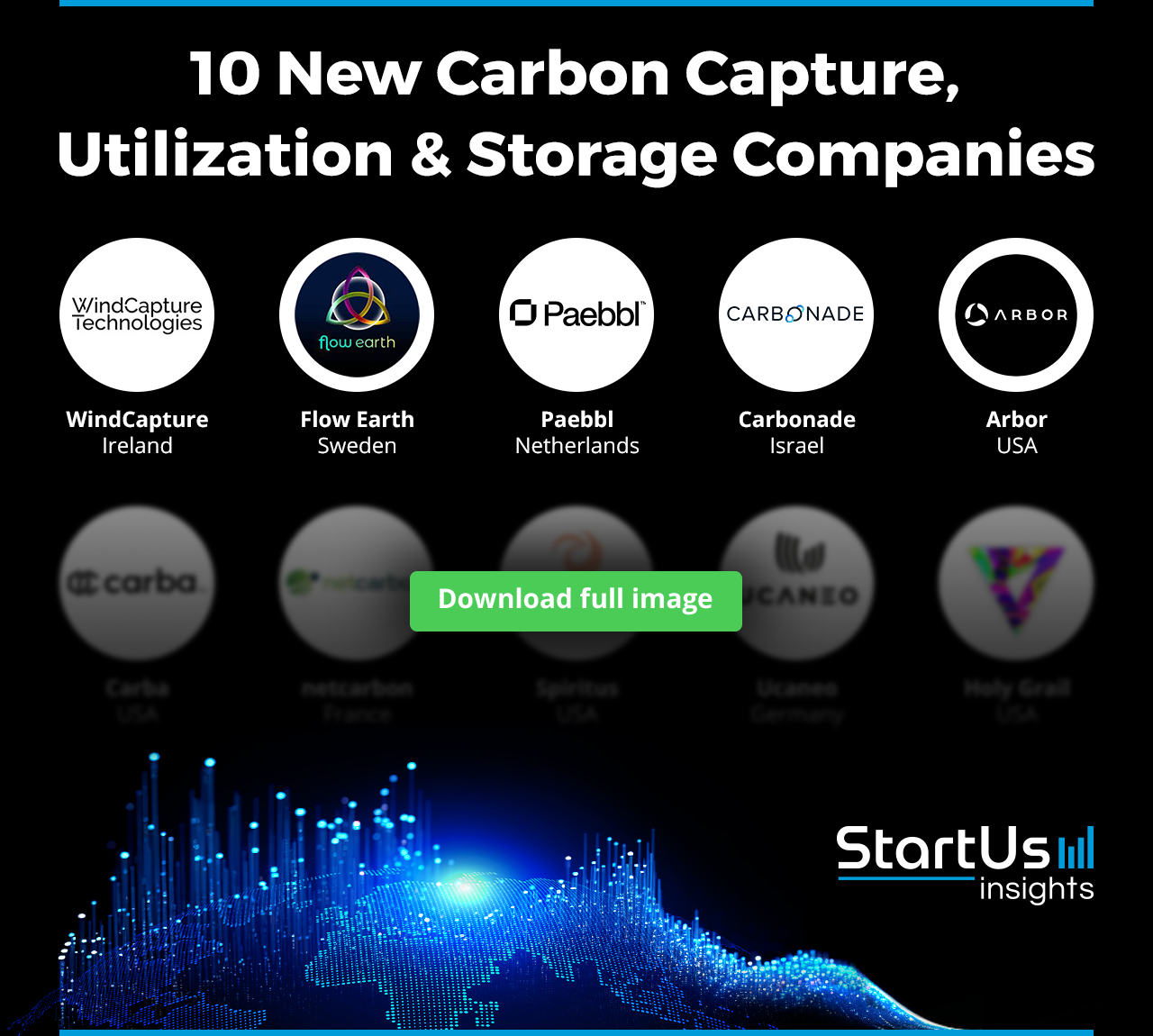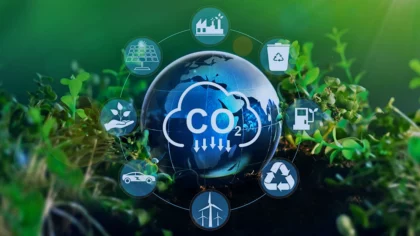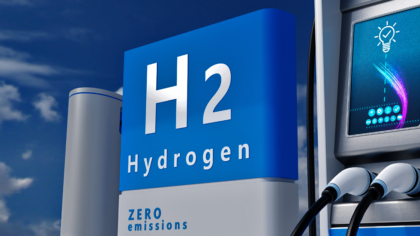This article presents an analytical review of 10 top new carbon capture, utilization, and storage companies. These firms work on low-energy carbon dioxide removal, providing efficient solutions for emissions reduction. They also specialize in advanced CO2 mineralization, converting greenhouse gases into solid minerals. For safer environmental practices, they offer solutions for above-ground CO2 storage.
Their expertise extends to electrochemical CO2 capture, improving the separation process. Additionally, they develop modular direct air capture (DAC) systems, enhancing scalability and accessibility. Each company contributes significantly to its field, showcasing the growing and varied applications of carbon capture technologies in combating climate change.
Continue reading to gain up-to-date and data-driven insights on:

Key Takeaways
Drawing insights from the Big Data & AI-powered StartUs Insights Discovery Platform that provides data on over 4.7+ million emerging companies globally, we explore the evolving landscape of the carbon capture, utilization, and storage industry. This sector is marked by key trends and a substantial workforce, shaping its future. Here are some key insights at a glance:
- Latest CCUS Trends: Some of the major trends advancing the CCUS industry are low-energy direct air capture systems, fluidization-based sequestration, biological carbon fixation, graphene-based CO2 removal, allam cycle technology, and enhanced rock weathering.
- CCUS Industry Statistics: The sector comprises 23K+ organizations worldwide. On average, it employs about 25 people in 4K+ new companies founded in the last five years, witnessing 2020 as the average founding year. Moreover, the average funding received by the CCUS industry per round in the same span is USD 28 million.
- Top 10 CCUS Companies to Watch:
- WindCapture – Wind Turbines-based CO2 Capture
- Flow Earth – C4 Grass-based CO2 Removal & Storage
- Paebbl – Advanced CO2 Mineralisation
- Carbonade – Single-Step Electrochemical CO2 Capture
- Arbor – Rocket Engine Tech-based Carbon Removal
- Holy Grail – Above-ground CO2 Storage
- Carba – Low Energy Carbon Dioxide Removal
- Spiritus – Modular DAC and Sequestration
- Ucaneo – Human Lung-inspired Biomimetic DAC
- netcarbon – Carbon Sequestration Measurement
Meet 10 out of 4K+ New Carbon Capture, Utilization, and Storage Companies
In this section, we highlight a list of new carbon capture, utilization, and storage companies that focus on low-energy CO2 capture, enhancing efficiency while reducing operational costs. They also develop carbon sequestration measurement tools, ensuring accurate tracking and storage of captured carbon.
Other innovative approaches include biomimetic direct air capture, mimicking natural processes for improved efficiency. Additionally, they explore wind turbine-based CO2 capture, integrating renewable energy with environmental preservation efforts. Dive into the article to discover the unique solutions these companies bring to the forefront of climate change mitigation.
Note on Signal Strength
One of the unique metrics we feature for each company is Signal Strength, a proprietary data point generated by our Discovery Platform. It gauges the extent to which a company’s influence has permeated the global ecosystem of startups, scaleups, and emerging companies. This proprietary metric serves as a valuable guidepost for understanding a company’s standing in the broader market landscape.
1. WindCapture
- Founding Year: 2022
- Employee Range: 2-10
- Location: Ireland
- Signal Strength: Strong
- What they do: WindCapture integrates a direct air capture (DAC) system into wind turbine blades. These blades capture carbon dioxide from the air during electricity generation. It then purifies the captured carbon dioxide using the generated power, creating a self-powered loop. This significantly reduces operating costs compared to traditional DAC methods. WindCapture’s technology leverages the natural scalability of wind turbines – doubling the blade length quadruples its carbon capture capacity. Furthermore, the system is designed for rapid production and can be retrofitted to existing turbines, enabling faster implementation and utilizing existing infrastructure.
2. Flow Earth
- Founding Year: 2020
- Employee Range: 2-10
- Location: Sweden
- Signal Strength: Very Strong
- What they do: Flow Earth employs a biochar-based system for CO2 removal. Fast-growing grasses efficiently capture atmospheric carbon dioxide. Once harvested, these grasses undergo conversion into biochar, a highly stable carbon-rich material that sequesters CO2 for thousands of years. The company then adds the biochar to soil, enriching it and enabling biodiverse farms to flourish. These farms not only continue to capture CO2 but also generate income streams that directly finance future carbon removal projects. Flow Earthe thus provides a nature-based solution for CO2 removal with long-term storage and potential for economic benefits.
3. Paebbl
- Founding Year: 2021
- Employee Range: 11-50
- Location: Netherlands
- Signal Strength: Very Strong
- What they do: Paebbl tackles CO2 emissions with a carbon capture and utilization (CCU) process. Its technology accelerates natural CO2 mineralization – a geological process that turns CO2 into rock over millions of years. Paebbl’s method accomplishes this within minutes using a low-energy reaction that combines captured carbon dioxide with abundant minerals. This reaction yields a carbon-negative raw material suitable for various industries like concrete and paper production. Paebbl thus offers a permanent CO2 storage solution with the additional advantage of creating an industrial product.
4. Carbonade
- Founding Year: 2022
- Employee Range: 2-10
- Location: Israel
- Signal Strength: Medium
- What they do: Carbonade tackles CO2 emissions in hard-to-abate industries with a single-step electrochemical CCU process. The method utilizes electrochemistry to directly convert captured CO2 and water into hydrogen and carbon monoxide (CO) at room temperature. This eliminates the need for separate capture, hydrogen production, and utilization steps. A proprietary catalyst facilitates this conversion with minimal energy input, resulting in a significant efficiency improvement. The CO is then further processed into sustainable aviation fuels (SAF) and polymers, offering a permanent storage solution for captured carbon.
5. Arbor
- Founding Year: 2022
- Employee Range: 11-50
- Location: USA
- Signal Strength: Very Strong
- What they do: Arbor captures and stores carbon dioxide using its Biomass Carbon Removal and Storage (BiCRS) solution. The process involves gasifying waste biomass and converting it into syngas. An oxy-combustion reaction then isolates pure CO2 from the syngas stream. The company then compresses this captured CO2 into a supercritical fluid and injects it deep underground. There, the CO2 naturally reacts with minerals to form stable limestone, achieving permanent geological storage.

6. Holy Grail
- Founding Year: 2019
- Employee Range: 2-10
- Location: USA
- Signal Strength: Very Strong
- What they do: Holy Grail captures CO2 directly from the air through its modular electrochemical scrubbers. These scrubbers utilize electricity from renewable sources to capture CO2, avoiding emissions associated with traditional CO2 capture methods. The captured CO2 then undergoes a mineralization process within the scrubber, transforming it into a stable solid form. The company then compacts these solid CO2 products into bricks for transportation and permanent storage in monitored above-ground locations. This eliminates the complexities and risks associated with traditional underground CO2 storage, while also simplifying the process of measuring, reporting, and verifying captured carbon.
7. Carba
- Founding Year: 2021
- Employee Range: 2-10
- Location: USA
- Signal Strength: Very Strong
- What they do: Carba uses its proprietary Biomass Torrefaction with Burial (BTB) process for permanent CO2 capture and storage. Its technology utilizes a low-energy reactor to convert various types of biomass waste into a stable, high-yield solid carbon product. This process requires minimal water and is deployable on-site for scalability. The captured carbon is used in net-negative products or permanently stored underground in an anoxic environment for over a thousand years. This way, Carba provides a solution for capturing and storing CO2 emissions while also promoting biomass waste utilization.
8. Spiritus
- Founding Year: 2021
- Employee Range: 11-50
- Location: USA
- Signal Strength: Very Strong
- What they do: Spiritus offers a proprietary DAC technology, Carbon Orchard for large-scale CO2 removal. This system utilizes a solid sorbent material Fruit to passively capture CO2 from the surrounding air. The captured CO2 then undergoes desorption in a low-temperature process, and the sorbent is recycled for continuous capture. The company’s method minimizes energy consumption compared to traditional DAC methods. Moreover, the modular design of the Carbon Orchard allows for rapid deployment and scalability.
9. Ucaneo
- Founding Year: 2022
- Employee Range: 2-10
- Location: Germany
- Signal Strength: Very Strong
- What they do: Ucaneo develops a biomimetic DAC technology inspired by the human lung. Its system utilizes enzymes and electrochemistry to capture CO2 at room temperature, avoiding the high energy demands of traditional DAC methods. Unlike conventional DAC that uses strong chemical bonds, Ucaneo creates weak bonds allowing for efficient CO2 release. The company’s modular and scalable electric units capture around 500-1000 tons of CO2 per unit and are easily deployable near CO2 utilization or storage sites.
10. netcarbon
- Founding Year: 2021
- Employee Range: 2-10
- Location: France
- Signal Strength: Very Strong
- What they do: netcarbon develops a satellite data and AI-powered platform for measuring and optimizing carbon storage across various land-use sectors. Its technology merges satellite imagery with ground truth data to create indicators for monitoring vegetation health and carbon capture. An AI algorithm analyzes this data to identify effective carbon storage practices and recommend improvements. netcarbon thus empowered sectors like agriculture, viticulture, and infrastructure development with cost-effective and scalable tools to track and enhance their carbon storage efforts.
Find New Carbon Capture, Utilization, and Storage Companies
Utilizing a SaaS platform like the Discovery Platform for identifying new carbon capture, utilization, and storage companies provides significant benefits compared to traditional scouting methods:
- Streamlined Efficiency: The Discovery Platform offers advanced tools that streamline the scouting process. It replaces your hours of conventional desk research, saving time and resources in identifying carbon capture, utilization, and storage innovations.
- Access to Real-time Insights: Gain a competitive edge with up-to-date information on the latest trends in the CCUS industry. The platform keeps you informed with news and near real-time updates on emerging carbon capture, utilization, and storage companies, enabling you to make swift and informed decisions.
- Precise Scouting: Customize your search to focus on specific niches within the CCUS sector, such as CO2 mineralization, biological carbon fixation, or enhanced rock weathering. The platform’s diverse filtering options allow you to target your scouting efforts precisely, ensuring that you find the most relevant and groundbreaking companies in the field.
Explore All carbon capture, utilization, and storage Companies!
We’ve explored the dynamic landscape of the carbon capture, utilization, and storage industry, examining the latest trends and spotlighting exceptional companies driving innovation. To dive deeper, download our free Decarbonization Report or schedule a demo of the Discovery Platform for a customized exploration of these groundbreaking developments.










